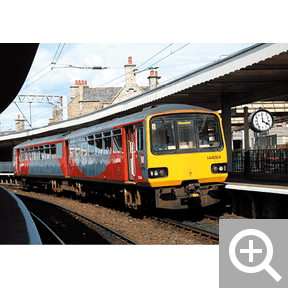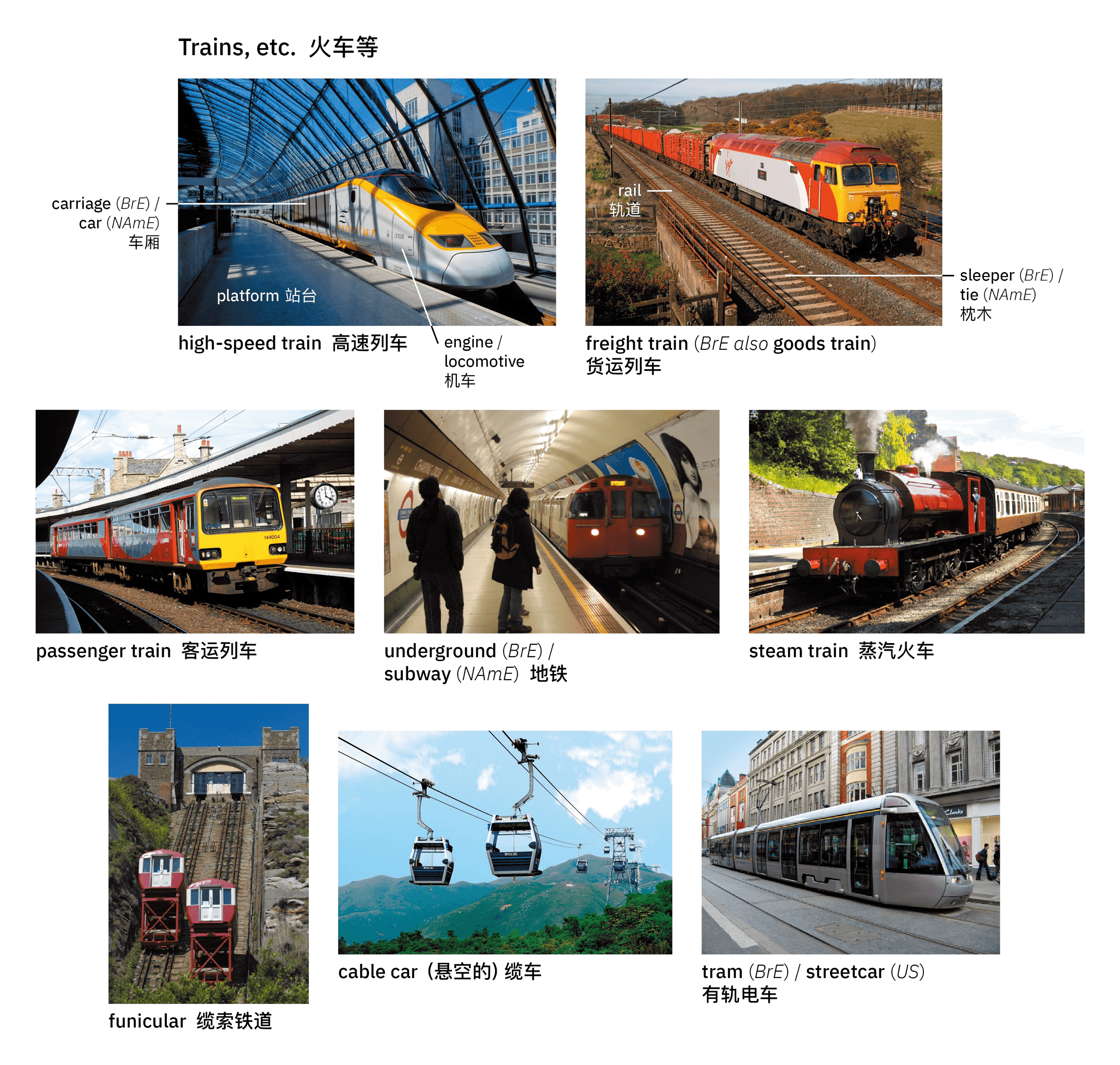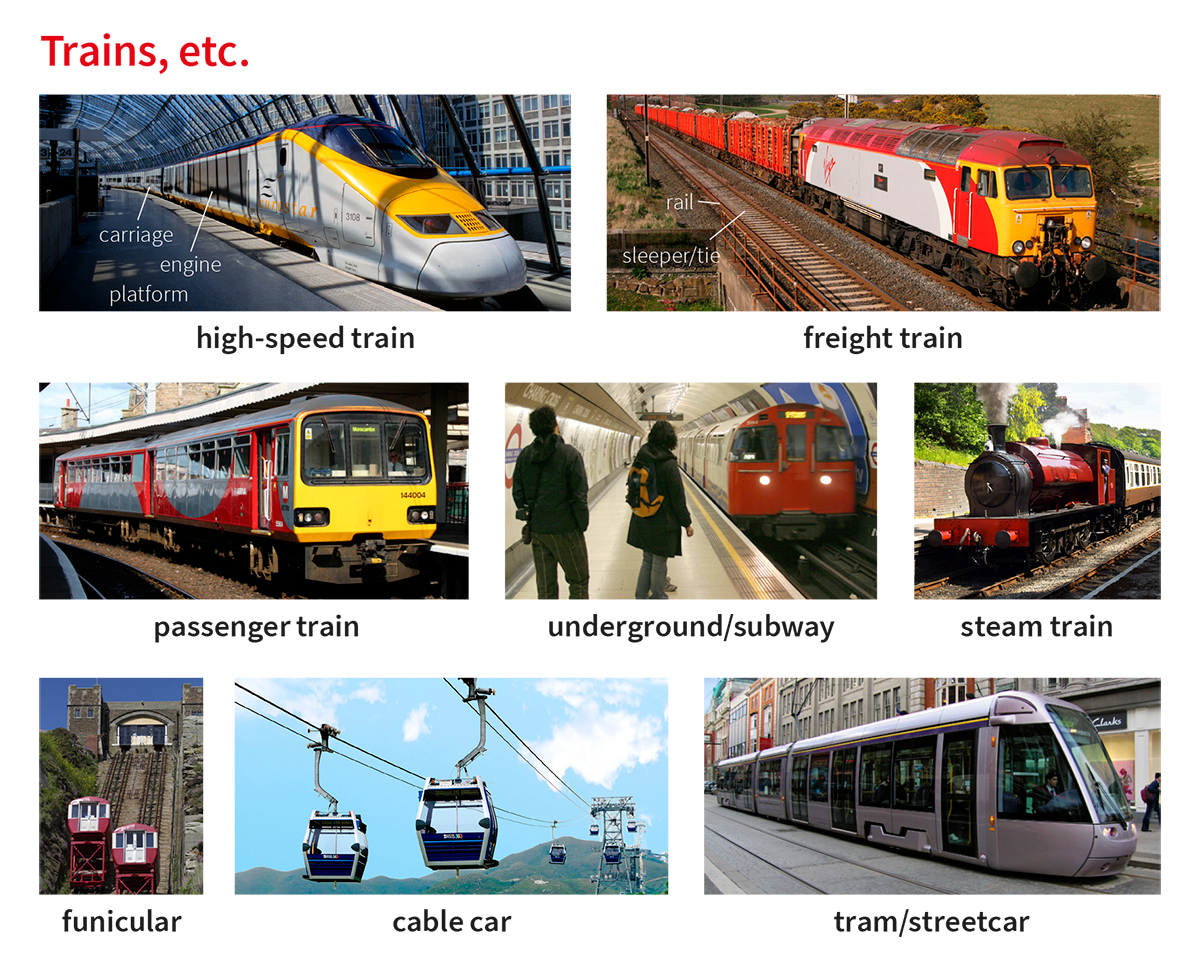-
a number of connected coaches or trucks, pulled by an engine or powered by a motor in each one, taking people and goods from one place to another 火車;列車 

to get on/off a train 上/下火車 - by train
I like travelling by train. 我喜歡乘火車旅行。 a passenger/commuter train 客運/通勤列車 an express/a steam/a bullet train 快車/蒸汽列車/動車 to catch/take/get the train to London 趕上/乘坐/搭乘開往倫敦的火車 He boarded the train in Kansas City. 他在堪薩斯城登上了火車。 a train journey/driver/operator 火車旅行/司機/操作員 Basel's main train station 巴塞爾的主要火車站 He boarded the train in Kansas City. 他在堪薩斯城登上了火車。 You have to change trains at Reading. 你得在雷丁換乘火車。 There are regular train services to Edinburgh and Glasgow. 有定期開往愛丁堡和格拉斯哥的火車服務。 The train is running late/on time. 火車晚點了/正點。 I was on a platform waiting for a train. 我在站台上等火車。
Culture railways and railroadsrailways and railroadsThe world's first railway along which passengers travelled on trains pulled by steam locomotives (= engines) was opened in 1825 between Stockton and Darlington in north-east England. By the early 1900s, when railways reached the height of their popularity, there were about 23 000 miles/37 000 kilometres of railway track. Victorian engineers such as Isambard Kingdom Brunel designed bridges for the railway, and architects designed station buildings such as St Pancras in London.The railways played a vital role in Britain's industrial development during the 19th and early 20th centuries. Later, with the invention of the internal-combustion engine (= the type of engine used in cars), road transport became more popular for both goods and passengers. In 1947 regional railway companies were nationalized (= the government became their owner) and were called British Rail (later BR), but following the Beeching report in 1963 many lines (= routes) were closed in order to save money. In 1994 the government decided that BR should return to being owned by private companies. Tracks and stations were made the responsibility of a company called Railtrack, while trains were once again operated by several companies on a regional basis.The railway network connects all the major towns in Britain, and now, via a high-speed service and the Channel Tunnel, links Britain with France and Belgium. People are encouraged to use trains and other forms of public transport to help reduce the amount of fuel being used and pollution. Railways are used for both short and long journeys, for commuting to work each day, and for transporting freight (= goods). Some routes are now electrified and have high-speed trains. Others still rely on diesel- powered engines. Some trains are old, dirty and carry too many people. They also have a reputation for being late, and jokes are often made about the excuses given for delays. These have included ‘leaves on the line’ in autumn, and ‘the wrong kind of snow’. Tickets are quite expensive, although some people, including students and older people, can get railcards which allow buy tickets at a reduced price. Cheaper fares are also available if tickets are booked in advance.Following several major railway accidents and the failure of the Railtrack company in 2002 the government set up Network Rail to be responsible for the railway system used by the train operating companies, private companies which run the trains. These companies provide information about trains to the public through their organization, National Rail.Many Americans don't travel by train, or railroad as it is generally called in the US. Passenger trains today mainly serve commuters (= people travelling to and from work) around large cities. The only major long-distance railway business is done by freight trains (BrE also goods trains).The first US railroad company was the Baltimore & Ohio Railroad in 1829, but its cars (BrE carriages) were pulled by horses. Steam power was used by the 1830s, and the Pullman car was invented in 1859. The Civil War led to the rapid development of railroads, and the nation was connected from east to west in 1869 when the Union Pacific Railroad and Central Pacific joined their tracks in Utah. The 20th century brought more powerful engines and huge stations, like Grand Central Station (officially Grand Central Terminal) in New York. The greatest period of US railroads began in the middle of the 19th century and lasted about 100 years. This time has been celebrated with popular songs like I've Been Working on the Railroad, Freight Train Blues, John Henry, Chattanooga Choo Choo, Orange Blossom Special and Casey Jones. Trains and railroad workers were also the subjects of many films and novels.After World War Twomany more people bought their own cars and no longer used trains as a means of transport. Union Pacific, once known for its two-level ‘dome lounge cars’ from which passengers could see the countryside they travelled through, stopped long-distance passenger services in 1971. Amtrak, a company controlled by the government, now runs the California Zephyr, the Texas Eagle and other trains but it is not very successful in attracting passengers.Some Americans are train buffs (= people who love trains and know a lot about them) and take special steam engine trips. They may also collect model trains, some of which are now valuable. In Britain both old and young visit railway museums, for example at York. Trainspotting (= recording the names and numbers of engines) used to be a popular hobby but is much less common now.Extra ExamplesTopics Transport by bus and traina1I can't stop now, I have a train to catch. 我現在不能停,我要趕火車。 I got the through train to Manchester. 我乘坐直達列車到了曼徹斯特。 I was late and had to run for my train. 我晚了,只得跑着趕火車了。 I'm going to the station to meet her off the train. 我要到車站接她下火車。 The company plans to run trains on key intercity routes. 公司計劃在主要城際路線上開通火車。 The high-speed train travels at 120 mph. 高速列車行駛的速度是每小時 120 英裏。 The last train leaves at 00.30. 末班列車零點 30 分出發。 The next train to arrive at Platform 2 is the 12.30 from Leeds. 下一輛到達2 號月台的火車是12 點30 分由利茲方向開來的。 The train now standing at Platform 3 is the 16.50 to Brighton. 現在停靠在 3 號站台的火車將於 16 點 50 分開往布賴頓。 The train terminated in Baltimore. 火車在終點站巴爾的摩停下來。 We had to get up early to make the 6 o'clock train for Florence. 我們得早起去趕6點開往佛羅倫薩的火車。 What are the times of the return trains? 回程列車都有幾點的? an express train bound for Edinburgh 開往愛丁堡的特快列車 the Paris to Brussels train 巴黎到布魯塞爾的列車 trains between Cape Town and Pretoria 來往於開普敦和比勒陀利亞之間的火車 train loads of iron ore 裝滿一列列火車的鐵礦石
Oxford Collocations Dictionaryadjective- railroad
- railway
- metro
- …
- take
- travel by
- ride
- …
- run
- start
- terminate
- …
- journey
- ride
- trip
- …
- aboard a/the train
- on a/the train
- on board a/the train
- …
- a train to catch
a number of people or animals moving in a line 列隊行進的人(或動物);隊列;行列 a camel train 駱駝隊
Oxford Collocations Dictionaryadjective- camel
- mule
- wagon
- …
- [usually singular]
a series of events or actions that are connected 一系列相關的事情(或行動) Oxford Collocations Dictionaryverb + train- set something in
- bring something in
- break
- …
- a train of events
- a train of thought
- in somebody’s train
the part of a long formal dress that spreads out on the floor behind the person wearing it 拖裾,裙裾(長禮服的曳地部分)
Word OriginMiddle English (as a noun in the sense ‘delay’): from Old French train (masculine), traine (feminine), from trahiner (verb), from Latin trahere ‘pull, draw’. Early noun senses were ‘trailing part of a robe’ and ‘retinue’; the latter gave rise to ‘line of travelling people or vehicles’, later ‘a connected series of things’. The early verb sense ‘cause a plant to grow in a desired shape’ was the basis of the sense ‘instruct’.
Idioms
bring something in its train
in somebody’s train
set something in train
a train of thought


